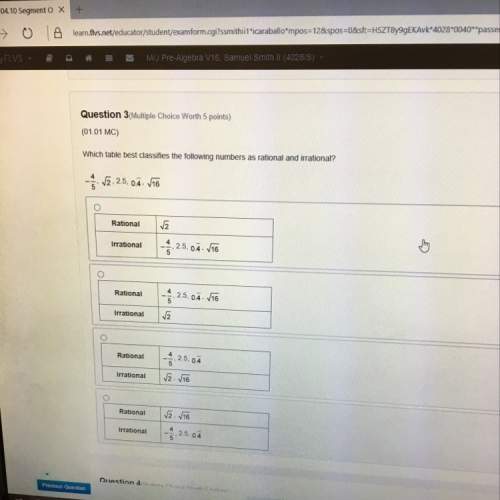Which statement is false?
a. all real numbers are complex numbers.
b. all irrational num...

Mathematics, 10.06.2021 21:40 warrenclanrocks
Which statement is false?
a. all real numbers are complex numbers.
b. all irrational numbers are real numbers.
c. all complex numbers are pure imaginary numbers.
d. all whole numbers are rational numbers

Answers: 1
Another question on Mathematics

Mathematics, 21.06.2019 18:30
(05.08a)triangle abc is transformed to similar triangle a′b′c′ below: a coordinate plane is shown. triangle abc has vertices a at 2 comma 6, b at 2 comma 4, and c at 4 comma 4. triangle a prime b prime c prime has vertices a prime at 1 comma 3, b prime at 1 comma 2, and c prime at 2 comma 2. what is the scale factor of dilation? 1 over 2 1 over 3 1 over 4 1 over 5
Answers: 3

Mathematics, 21.06.2019 22:30
60 musicians applied for a job at a music school. 14 of the musicians play both guitar and drums, 28 play drums, 18 play the guitar. what is the probability that the applicant who gets the job plays drums or guitar?
Answers: 1

Mathematics, 21.06.2019 22:50
He graph of f(x) = |x| is stretched by a factor of 0.3 and translated down 4 units. which statement about the domain and range of each function is correct? the range of the transformed function and the parent function are both all real numbers greater than or equal to 4. the domain of the transformed function is all real numbers and is, therefore, different from that of the parent function. the range of the transformed function is all real numbers greater than or equal to 0 and is, therefore, different from that of the parent function. the domain of the transformed function and the parent function are both all real numbers.
Answers: 3

Mathematics, 22.06.2019 02:30
Atrain traveled for 1.5 hours to the first station, stopped for 30 minutes, then traveled for 4 hours to the final station where it stopped for 1 hour. the total distance traveled is a function of time. which graph most accurately represents this scenario? a graph is shown with the x-axis labeled time (in hours) and the y-axis labeled total distance (in miles). the line begins at the origin and moves upward for 1.5 hours. the line then continues upward at a slow rate until 2 hours. from 2 to 6 hours, the line continues quickly upward. from 6 to 7 hours, it moves downward until it touches the x-axis a graph is shown with the axis labeled time (in hours) and the y axis labeled total distance (in miles). a line is shown beginning at the origin. the line moves upward until 1.5 hours, then is a horizontal line until 2 hours. the line moves quickly upward again until 6 hours, and then is horizontal until 7 hours a graph is shown with the axis labeled time (in hours) and the y-axis labeled total distance (in miles). the line begins at the y-axis where y equals 125. it is horizontal until 1.5 hours, then moves downward until 2 hours where it touches the x-axis. the line moves upward until 6 hours and then moves downward until 7 hours where it touches the x-axis a graph is shown with the axis labeled time (in hours) and the y-axis labeled total distance (in miles). the line begins at y equals 125 and is horizontal for 1.5 hours. the line moves downward until 2 hours, then back up until 5.5 hours. the line is horizontal from 5.5 to 7 hours
Answers: 1
You know the right answer?
Questions

History, 09.12.2019 03:31



Mathematics, 09.12.2019 03:31



Mathematics, 09.12.2019 03:31



Chemistry, 09.12.2019 03:31

Biology, 09.12.2019 03:31

Mathematics, 09.12.2019 03:31

Mathematics, 09.12.2019 03:31



Mathematics, 09.12.2019 03:31



Physics, 09.12.2019 03:31

History, 09.12.2019 03:31




